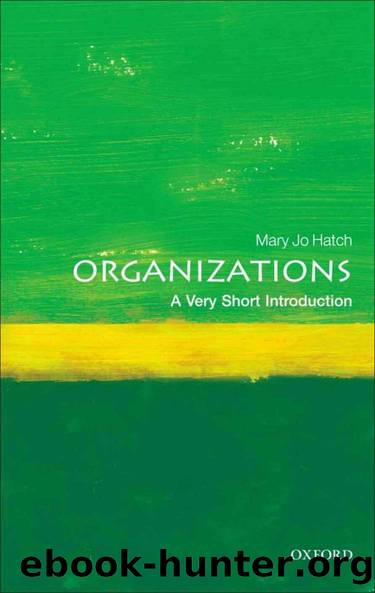Organizations: A Very Short Introduction (Very Short Introductions) by Hatch, Mary Jo (2011) Paperback by Mary Jo Hatch

Author:Mary Jo Hatch [Hatch, Mary Jo]
Language: eng
Format: epub
Amazon: B00IGYZVDI
Publisher: OUP Oxford
Published: 2011-03-23T16:00:00+00:00
The politics of identity and diversity
Feminists often argue that stereotypes cause us to discredit and devalue some members of society. They point to the fact that the high-paying, prestigious jobs that carry with them the greatest social status and power are inequitably distributed across many dimensions of social identity, including gender, race, ethnicity, religious or sexual preference, and age. Stereotypes of marginalized identity groups serve to make it seem natural that their members take certain jobs or occupy particular roles, typically those offering lower pay and conferring less power and status. The disproportion of white males in positions of power and authority across capitalistic societies provides convincing evidence.
A popular idea among feminists is that work in private life is associated with the feminine ideals of caring and community, while work in public life is rational and competitive, characteristics long associated with the stereotypical male. A number of feminist scholars have argued that this public/private separation of male and female domains reinforces a dualistic view of gender that helps to define the identities of men and women and shapes interaction between them.
Dualism refers to the relationship between two opposing terms, which can be seen as complementary (‘you are the yin to my yang’) or contradictory (‘are you for or against me?’). Feminists argue that dualism reinforces traditional relations of domination/subordination, thus perpetuating the existing social order. In addition to public/private, other dualisms – rational/emotional, hard/soft, active/passive – similarly underscore male/female differences, allowing them to endure in the face of persistent calls to redefine gender relations.
To see how pervasive this effect can be, try reading each of the pairs mentioned above in reverse order (e.g. emotional/rational). Does it feel strange to do this? Feminists often substitute ‘she’ for ‘he’ in their writing to normalize the feminine in language and make focusing on women as familiar as is the focus upon men. To the extent that the exercise above did not make you uncomfortable, perhaps they have succeeded!
Feminist sociologist Joan Acker (1924– ) transferred ideas about gender to organizations when she introduced the concept of gendered organizations. Assuming that gender is constructed by social practices that produce gender-based power relations, Acker argued that those in power determine important outcomes using language in gendered (i.e. non-gender-neutral) ways. When those in power are mostly male, they dominate the discourse that keeps them in power, including how women will be described and evaluated, and thus relegated to less influential jobs with lower status and power. Such attitudes socially construct organizations that are gendered through and through.
A consulting firm once asked me to observe and give feedback on their employee evaluation process. As each employee’s name came up for consideration during the annual determination of raises and promotions, I noted the language used by those performing the evaluations, all of them men. Whereas the male candidates were never described by the word ‘aggressive,’ all the women were, and what is more, each woman was described as either too aggressive or not aggressive enough.
Not only was the aggression
Download
This site does not store any files on its server. We only index and link to content provided by other sites. Please contact the content providers to delete copyright contents if any and email us, we'll remove relevant links or contents immediately.
Cecilia; Or, Memoirs of an Heiress — Volume 1 by Fanny Burney(31333)
Cecilia; Or, Memoirs of an Heiress — Volume 3 by Fanny Burney(30934)
Cecilia; Or, Memoirs of an Heiress — Volume 2 by Fanny Burney(30889)
The Great Music City by Andrea Baker(21313)
We're Going to Need More Wine by Gabrielle Union(18073)
Bombshells: Glamour Girls of a Lifetime by Sullivan Steve(13108)
Pimp by Iceberg Slim(12931)
All the Missing Girls by Megan Miranda(12749)
Fifty Shades Freed by E L James(12451)
Norse Mythology by Gaiman Neil(11883)
Talking to Strangers by Malcolm Gladwell(11879)
Crazy Rich Asians by Kevin Kwan(8349)
Mindhunter: Inside the FBI's Elite Serial Crime Unit by John E. Douglas & Mark Olshaker(7834)
The Lost Art of Listening by Michael P. Nichols(6474)
Enlightenment Now: The Case for Reason, Science, Humanism, and Progress by Steven Pinker(6405)
Bad Blood by John Carreyrou(5769)
The Four Agreements by Don Miguel Ruiz(5511)
Weapons of Math Destruction by Cathy O'Neil(5037)
We Need to Talk by Celeste Headlee(4869)
